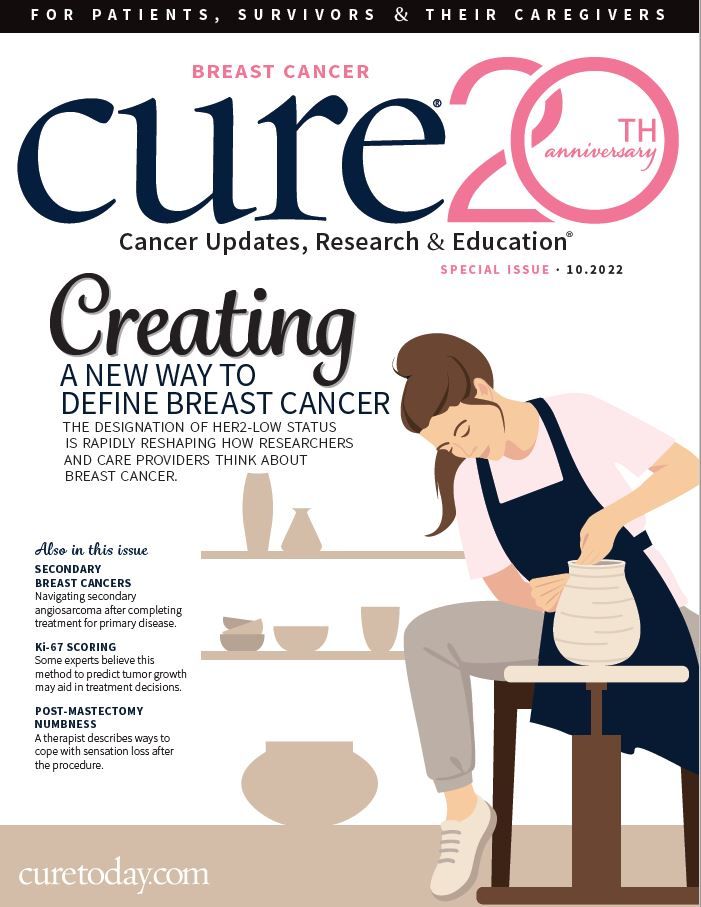Publication
Article
CURE
How Breast Cancer Survivors, Patients Can Cope With Sensation Loss and Numbness After a Mastectomy
Chest numbness following a mastectomy can be truly daunting, but patients with breast cancer don’t have to suffer in silence — and it may not be something they have to live with.
Just as a loss of hearing or sight can fundamentally shape a patient’s identity, so too can a loss of sensation, especially in an area of the body as essential to one’s identity as the breasts.
For many women, the breasts and chest are not only part of their sexuality, but also part of their identity. That’s why a lack of sensation, according to Carla Marie Manly, can feel like walking through the world with a piece of you missing.

For many women, the breasts and chest are not only part of their sexuality, but also part of their identity. That’s why a lack of sensation can feel like walking through the world with a piece of you missing.
Chest numbness is a common side effect of mastectomy. This may be acknowledged as a possible side effect in the preoperative paperwork, but a patient may not be prepared for the actual effects it will have on their quality of life as a cancer survivor or previvor. The chest area accounts for nearly 10% of a body’s surface, and it’s the heart space that a person presents to the world.
It can be difficult to grasp the full effect of a lack of sensation, especially in the whirlwind of being diagnosed with breast cancer or the BRCA1 or BRCA2 gene. A hug no longer has that enveloping power. A woman may not be able to feel her child’s head against her chest as she rocks them to sleep. How she interacts with her romantic partner may shift. She may move through the world silently feeling “different” from other women.
The good news is that patients don’t have to cope with this side effect on their own — and it may not be something they have to live with. Thanks to recent advances in treatment, there is hope to restore sensation during breast reconstruction or some revision surgeries.
Speak Up, Investigate Options
A patient who underwent a mastectomy may be hesitant to talk about chest numbness. Perhaps she feels an overwhelming sense of “I should just be grateful to be alive” and worries that others will think it’s trivial. In truth, a person can feel deeply grateful to be alive and also desire to live without a loss of chest sensation.
It’s natural to want to have sensation in all parts of one’s body — especially the intimate area of one’s chest.
In my practice as a clinical psychologist, my first course of action when a client mentions chest numbness is to suggest they talk with their physician to determine if any medical interventions are available. It’s wise, however, to be proactive whenever possible, meaning that a woman doesn’t have to wait until after mastectomy to address the potential for numbness with her oncology care team.
Surgical intervention could potentially restore sensation. During a mastectomy, nerves are severed when cancerous breast tissue is removed. If the nerves aren’t surgically repaired, the connection is lost between the skin on one’s chest and their brain — hence, a lack of sensation.
Even women who had a mastectomy years ago may have options. With breast neurotization (breast nerve repair), a specially trained plastic reconstructive surgeon may be able to reconnect nerves cut during the mastectomy using a nerve graft at the time of breast reconstruction or during some revision procedures.
Nerves regenerate over time, which can lead to regaining sensation in the chest and breasts. Many plastic surgeons who perform breast neurotization report that women typically start to regain sensation several months after surgery and that the feelings can continue to develop for up to two years.
Strategies for Coping
Patients who lose sensation in their chest area following a mastectomy don’t have to settle for going through life as though a piece of them is missing. A skilled mental health professional can help them prepare for sensation loss prior to surgery and develop the tools to cope as they go forward in their cancer journey.
Although everyone has experienced temporary numbness before — whether it’s a foot that’s fallen asleep from sitting too long or numbness following a dental procedure — it can be hard to imagine what that numbness would be like over a large part of the body. I can’t fully prepare my clients for what it may feel like to lose sensation in their chest area, but I can guide them through visualizations and demonstrations.
For instance, I may have a client hug their partner with a piece of cardboard between them to prepare for what having a sensation barrier might feel like. I may also support the client in learning how to talk about the numbness in an age-appropriate way with a child or other loved one.
Self-care is also vital as a woman heals and moves toward embodying herself fully. With a lack of sensation, the breasts may feel like a “hands off” area, but my advice is to show that area self-care in ways that bring joy, such as doing self-massages and using essential oils.
One’s chest may not have sensation yet, but it can still be a loved part of their being.
The most powerful thing that can be done is to talk about it with loved ones, the cancer care team and other survivors. There are physical and emotional ways to move forward after a mastectomy, but they are only possible by bringing the sadness, embarrassment and pain of sensation loss into the light.
This article was written and submitted by Carla Marie Manly, PhD. Manly is a clinical psychologist based in Sonoma County, California.
For more news on cancer updates, research and education, don’t forget to subscribe to CURE®’s newsletters here.





